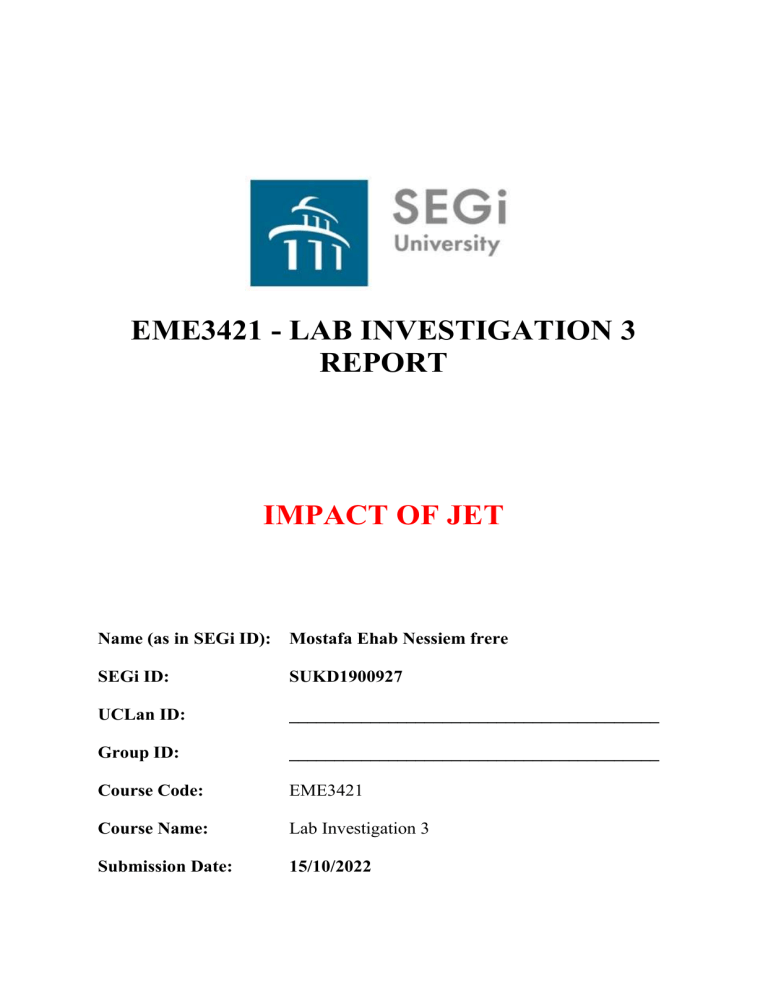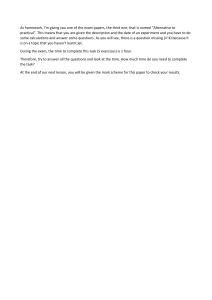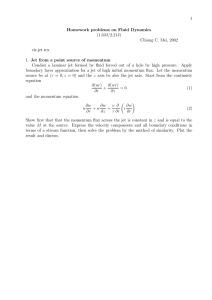
EME3421 - LAB INVESTIGATION 3 REPORT IMPACT OF JET Name (as in SEGi ID): Mostafa Ehab Nessiem frere SEGi ID: SUKD1900927 UCLan ID: _________________________________________ Group ID: _________________________________________ Course Code: EME3421 Course Name: Lab Investigation 3 Submission Date: 15/10/2022 1. Abstract This objective of this experiment is to study the jet forces impacting against stationary deflectors. The deflectors used in this experiment can be categorised into three geometries. Plate, hemisphere and slope deflectors are used for this experiment. Calculated force, Fth and the percentage of error will be calculated in this experiment. 2. Objective(s) -To investigate the momentum equation experimentally produced by the impact of a jet of water on to various target vanes. -To understand how this force affects the rate of momentum flow in the jet. 3. Introduction/ Theoretical Background Water turbines are widely used throughout the world to generate power. By allowing fluid under pressure to strike the vanes of a turbine wheel, mechanical work can be produced. Rotational motion is then produced by the force generated as the jet strikes the vanes. One of the common types of water turbines is Pelton wheel. In this type of water turbine, one or more water jets are directed tangentially on to a vanes or buckets that are fastened on the rim of the turbine disc. The impact of the water on the vanes generates a torque on the wheel causing it to rotate and to develop power. To predict the output of a Pelton wheel and to determine its optimum rotational speed, understanding on how the deflection of the jet generates a force on the buckets and how the force is related to the rate of momentum flow in the jet are needed. This experiment aims at assessing the different forces exerted by the same water jet on a variety of geometrical different plates. Under this experiment, the force generated by a jet of water striking a deflector is measured. The impact forces are measured using a lever mechanism and loading weights. The impact forces of water jet are set via flow rate. Normally, the jet of water with average velocity W from the nozzle impinges straight on the impact surface and turns to flow radially outward from the axis of the impact surfaces. Thus, the theoretical jet force can be calculated from the principle of linear momentum. And the density of the water is ρ = 1 kg/L. For plate: 4. Apparatus Loading weights Lever mechanism Deflector Nozzle Perspex vessel Drain connection Base plate Inlet connection Various deflectors (Plate – cone) A set of weights stop watch 5. Experimental Method A quick inspection is performed to ensure the unit is operating in proper condition. A hose connection was made and the unit was connected to the nearest power supply. The discharge pipe was opened. Plate deflector was assembled. The 3 screws on the cover were loosen. The cover and the lever mechanism were then removed. An appropriate deflector was fitted. The lock nut was tightened on the rod. The cover was screwed onto vessel. Adjusting screw was used to set pointer to zero. No weights were placed on the measurement system while doing so. 5 different sets of weight 1N, 2N, 3N, 4N, 5N were applied. Main clock was closed. The pump is then switched on and the main cock was opened carefully until pointer is on zero again. Drain cock was closed and the volumetric flow rate was determined. Stopwatch was used to establish time required for raising the level in the volumetric tank from 20 to 30 liters. The pump was switched off and drain was opened. Repeat steps for cone deflector. 6. Results and Analysis Table 1.1 Results of Measurement for 45º deflection Deflector Force F in N 1 2 3 4 5 Plate (45º deflection) Measuring time in s 46.7 34.17 28.10 24.30 22.24 Flow rate in litter per second 0.214 0.293 0356 0.412 0.450 Table 1.2 Results of Measurement for 90º deflection Deflector Force F in N 1 2 3 4 5 Plate (90º deflection) Measuring time in s 33.55 25.52 20.56 18.32 16.88 Flow rate in liter per second 0.298 0.392 0.486 0.546 0.592 Table 2.1 Results of Force Calculation for 90º deflection Deflector Flow rate in litre per second 0.298 0.392 0.486 0.546 0.592 Plate (90º deflection) Velocity w1 3.794 4.991 6.188 6.952 7.538 Calculated force Fth in N 1.184 1.956 3.007 3.796 4.462 Measured force F in N 1 2 3 4 5 Percentage error 18.4% 2.2% 0.23% 5.1% 10.76% Table 2.2 Results of Force Calculation for 45º deflection Deflector Flow rate in litre per second 0.214 0.293 0.356 0.412 0.450 Plate (45º deflection) Velocity w1 Calculated force Fth in N 2.725 0.875 3.731 1.640 4.533 2.421 5.246 3.242 5.730 3.868 Measured force F in N 1 2 3 4 5 Percentage error 12.5% 18% 19.3% 18.95% 22.64% Calculations: Sample calculations: Volumetric Flow 𝑉 = 𝑣𝑜𝑙𝑢𝑚𝑒 𝑡𝑖𝑚𝑒 𝑉 = 0.01 46.72 𝑉 = 𝟐. 𝟏𝟒 𝒙𝟏𝟎−𝟒 𝒎𝟑/𝒔 Velocity, 𝑾𝟏 𝑊1 = 𝑉 𝐴𝐷 𝐴𝐷 = 𝜋𝑑2 4 d = 10mm 𝐴𝐷 = 𝜋(0.01)2 4 = 7.854 𝑥 10−5 𝑊1 = 2.14 𝑥 10−4 7.854 𝑥 10−5 𝑊1 = 𝟐. 𝟕𝟐𝟓 𝒎/𝒔2 𝑭𝒕𝒉 in N For cone, 𝐹𝑡ℎ = 𝑉𝜌𝑊1(1 + 𝑐𝑜𝑠2𝛼) 𝐹𝑡ℎ = 2.14 𝑥 10−4 × 1000 × 2.725 × (1 + 𝑐𝑜𝑠245°) 𝐹𝑡ℎ = 𝟎. 𝟖𝟕𝟓 𝑵 For plate, 𝐹𝑡ℎ = 𝑉𝜌𝑊1 𝐹𝑡ℎ = 2.98 𝑥10−4 × 1000 × 3.974 𝐹𝑡ℎ = 𝟏. 𝟏𝟖𝟒 𝑵 iv Percentage error in Force For cone, % 𝑒𝑟𝑟𝑜𝑟 = 𝑡ℎ𝑒𝑜𝑟𝑒𝑡𝑖𝑐𝑎𝑙 𝑣𝑎𝑙𝑢𝑒 − 𝑚𝑒𝑎𝑠𝑢𝑟𝑒𝑑 𝑣𝑎𝑙𝑢𝑒 𝑚𝑒𝑎𝑠𝑢𝑟𝑒𝑑 𝑣𝑎𝑙𝑢𝑒 % 𝑒𝑟𝑟𝑜𝑟 = 0.875 − 1 1 % 𝑒𝑟𝑟𝑜𝑟 = 𝟏𝟐. 𝟓 % x 100% x 100% For plate, % 𝑒𝑟𝑟𝑜𝑟 = 𝑡ℎ𝑒𝑜𝑟𝑒𝑡𝑖𝑐𝑎𝑙 𝑣𝑎𝑙𝑢𝑒 − 𝑚𝑒𝑎𝑠𝑢𝑟𝑒𝑑 𝑣𝑎𝑙𝑢𝑒 𝑚𝑒𝑎𝑠𝑢𝑟𝑒𝑑 𝑣𝑎𝑙𝑢𝑒 x 100% % 𝑒𝑟𝑟𝑜𝑟 = 1.184 − 1 1 x 100% % 𝑒𝑟𝑟𝑜𝑟 = 𝟏𝟖. 𝟒 % 7. Discussion Discussion differences obtained from the experiment as compared to theoretical calculation A theoretical said that to hold impact surface stationary is obtained by applying hinterland forms of the continuity and momentum equations. The details of the model depend on whether or not the fluid stream leaving the impact surface is symmetric relative to the vertical axis of the surface however from the experiment its obviously there is a bit differences from theoretical that is more accurate . Accuracy of the Experiment and ways of Improving it There were several possible errors that might have been encountered during the experiment and they are as follows: • A possible error could have been that while recording the time, the experimenter may have started recording earlier than intended or they may have stopped the stopwatch later than it was supposed to. This is usually a result of the typical human reaction time and can be improved by taking several readings and making sure to ignore any outlier readings. • An error may have occurred whilst reading the level in the volumetric tank. It could be that the volume used was not exactly 10 L. If true, this error has to be corrected by marking the start and the end level with a pen to be observable next time. • The pointer may have not been precisely set to zero due to parallax error. This can be corrected by viewing the pointer perpendicularly. • The effect of gravity on the water jet was neglected. The velocity of water jet will actually decrease as it leaves the nozzle before colliding the target surface. The decrease in velocity due to gravity will result in more mass needed to produce the effect of the same volumetric flow rate. 8. Conclusion As a conclusion, this experiment gives a better understanding about fluid pressure and its related machines. To investigative the effects of a jet flow on differently shaped targets, comparing theoretical predictions with actual measurements. It’s another way to understand fluid pressure by using the pressure to accelerate the fluid to a plate by adding high velocity in a jet which in result will generate Force due to impulse Both of the forces will have directly proportional relation. Theoretically, the calculated force should be the same as the measure force. However, this cannot be achieved experimentally due to the errors made during the experiment. 9. References (Following Harvard Referencing) 1- White, F.M. and Frank, W. (2003) Fluid mechanics - 5th edition.5th. edn. New York, NY: McGraw Hill Higher Education 2- R.K. Bansal 1983, A Textbook of Fluid Mechanics and Hydraulic Machines, 1st Edition, Laxmi Publications (P) Ltd, India. 3- Janna, W.S. (2009) Introduction to fluid mechanics, fourth edition. 4th edn. Boca Raton: Taylor & Francis 4- Rama Durgaiah, 2002, Fluid Mechanics and Machinery, 1st Edition, New Age International (P) Ltd, India.


